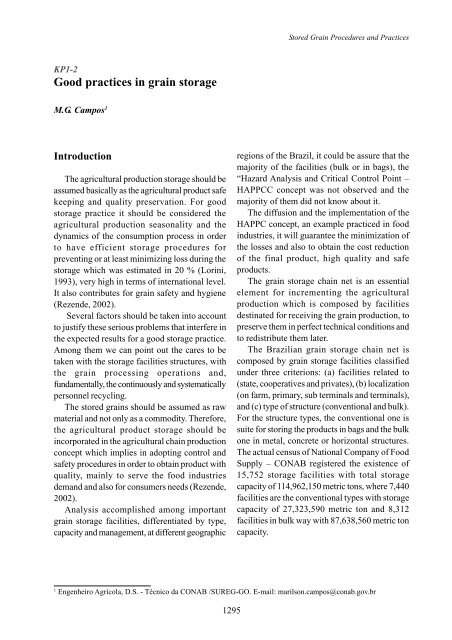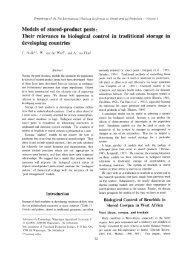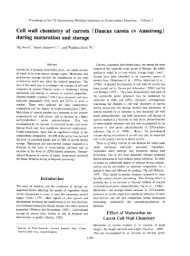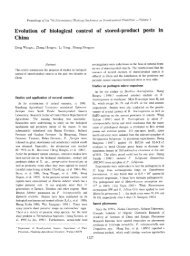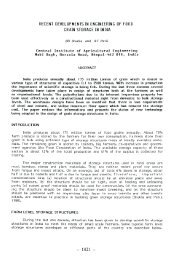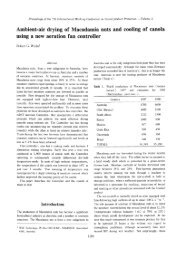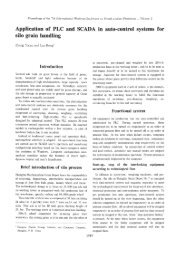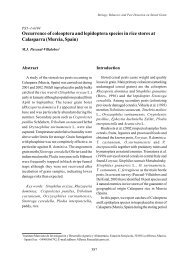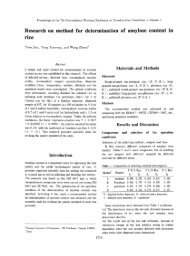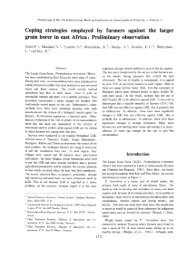Good practices in grain storage - SPIRU Local Index Page
Good practices in grain storage - SPIRU Local Index Page
Good practices in grain storage - SPIRU Local Index Page
You also want an ePaper? Increase the reach of your titles
YUMPU automatically turns print PDFs into web optimized ePapers that Google loves.
KP1-2<br />
<strong>Good</strong> <strong>practices</strong> <strong>in</strong> gra<strong>in</strong> <strong>storage</strong><br />
M.G. Campos 1<br />
Introduction<br />
The agricultural production <strong>storage</strong> should be<br />
assumed basically as the agricultural product safe<br />
keep<strong>in</strong>g and quality preservation. For good<br />
<strong>storage</strong> practice it should be considered the<br />
agricultural production seasonality and the<br />
dynamics of the consumption process <strong>in</strong> order<br />
to have efficient <strong>storage</strong> procedures for<br />
prevent<strong>in</strong>g or at least m<strong>in</strong>imiz<strong>in</strong>g loss dur<strong>in</strong>g the<br />
<strong>storage</strong> which was estimated <strong>in</strong> 20 % (Lor<strong>in</strong>i,<br />
1993), very high <strong>in</strong> terms of <strong>in</strong>ternational level.<br />
It also contributes for gra<strong>in</strong> safety and hygiene<br />
(Rezende, 2002).<br />
Several factors should be taken <strong>in</strong>to account<br />
to justify these serious problems that <strong>in</strong>terfere <strong>in</strong><br />
the expected results for a good <strong>storage</strong> practice.<br />
Among them we can po<strong>in</strong>t out the cares to be<br />
taken with the <strong>storage</strong> facilities structures, with<br />
the gra<strong>in</strong> process<strong>in</strong>g operations and,<br />
fundamentally, the cont<strong>in</strong>uously and systematically<br />
personnel recycl<strong>in</strong>g.<br />
The stored gra<strong>in</strong>s should be assumed as raw<br />
material and not only as a commodity. Therefore,<br />
the agricultural product <strong>storage</strong> should be<br />
<strong>in</strong>corporated <strong>in</strong> the agricultural cha<strong>in</strong> production<br />
concept which implies <strong>in</strong> adopt<strong>in</strong>g control and<br />
safety procedures <strong>in</strong> order to obta<strong>in</strong> product with<br />
quality, ma<strong>in</strong>ly to serve the food <strong>in</strong>dustries<br />
demand and also for consumers needs (Rezende,<br />
2002).<br />
Analysis accomplished among important<br />
gra<strong>in</strong> <strong>storage</strong> facilities, differentiated by type,<br />
capacity and management, at different geographic<br />
1295<br />
Stored Gra<strong>in</strong> Procedures and Practices<br />
regions of the Brazil, it could be assure that the<br />
majority of the facilities (bulk or <strong>in</strong> bags), the<br />
“Hazard Analysis and Critical Control Po<strong>in</strong>t –<br />
HAPPCC concept was not observed and the<br />
majority of them did not know about it.<br />
The diffusion and the implementation of the<br />
HAPPC concept, an example practiced <strong>in</strong> food<br />
<strong>in</strong>dustries, it will guarantee the m<strong>in</strong>imization of<br />
the losses and also to obta<strong>in</strong> the cost reduction<br />
of the f<strong>in</strong>al product, high quality and safe<br />
products.<br />
The gra<strong>in</strong> <strong>storage</strong> cha<strong>in</strong> net is an essential<br />
element for <strong>in</strong>crement<strong>in</strong>g the agricultural<br />
production which is composed by facilities<br />
dest<strong>in</strong>ated for receiv<strong>in</strong>g the gra<strong>in</strong> production, to<br />
preserve them <strong>in</strong> perfect technical conditions and<br />
to redistribute them later.<br />
The Brazilian gra<strong>in</strong> <strong>storage</strong> cha<strong>in</strong> net is<br />
composed by gra<strong>in</strong> <strong>storage</strong> facilities classified<br />
under three criterions: (a) facilities related to<br />
(state, cooperatives and privates), (b) localization<br />
(on farm, primary, sub term<strong>in</strong>als and term<strong>in</strong>als),<br />
and (c) type of structure (conventional and bulk).<br />
For the structure types, the conventional one is<br />
suite for stor<strong>in</strong>g the products <strong>in</strong> bags and the bulk<br />
one <strong>in</strong> metal, concrete or horizontal structures.<br />
The actual census of National Company of Food<br />
Supply – CONAB registered the existence of<br />
15,752 <strong>storage</strong> facilities with total <strong>storage</strong><br />
capacity of 114,962,150 metric tons, where 7,440<br />
facilities are the conventional types with <strong>storage</strong><br />
capacity of 27,323,590 metric ton and 8,312<br />
facilities <strong>in</strong> bulk way with 87,638,560 metric ton<br />
capacity.<br />
1 Engenheiro Agrícola, D.S. - Técnico da CONAB /SUREG-GO. E-mail: marilson.campos@conab.gov.br
9 th International Work<strong>in</strong>g Conference on Stored Product Protection<br />
<strong>Good</strong> <strong>practices</strong> <strong>in</strong> gra<strong>in</strong> <strong>storage</strong><br />
Hazard Analysis and Critical Control Po<strong>in</strong>t<br />
System - HACCP<br />
The <strong>in</strong>crease of demand from the food<br />
<strong>in</strong>dustries for better raw materials it should alert<br />
the producers, gra<strong>in</strong> <strong>storage</strong> facility owners and<br />
managers the conscience toward a professional<br />
posture and adoption of the systematic practice<br />
and procedures to be taken <strong>in</strong> their gra<strong>in</strong> <strong>storage</strong><br />
facilities.<br />
Assum<strong>in</strong>g the several factors related to the<br />
losses occurr<strong>in</strong>g dur<strong>in</strong>g the gra<strong>in</strong> <strong>storage</strong> process<br />
it could be po<strong>in</strong>ted out some aspects that should<br />
be taken <strong>in</strong>to account such as the facility structure<br />
care, the gra<strong>in</strong> process<strong>in</strong>g and ma<strong>in</strong>ly concern to<br />
the collaborators and also with the use of <strong>Good</strong><br />
Manufactur<strong>in</strong>g Practices, conveniently adapted<br />
to the necessity and peculiarity to the need of the<br />
gra<strong>in</strong> <strong>storage</strong> facility represent<strong>in</strong>g ga<strong>in</strong>s for the<br />
sector.<br />
The <strong>Good</strong> Manufactur<strong>in</strong>g Practices–GMP and<br />
the HACCP are worldwide known and<br />
implemented <strong>in</strong> the food <strong>in</strong>dustries with the<br />
objectives of quality guarantee and safe food<br />
besides the loss reduction (Mortimore, 1996).<br />
The gra<strong>in</strong> <strong>storage</strong> facilities <strong>in</strong> Brazil, <strong>in</strong><br />
contrary, there is no concern with the mentioned<br />
recommended procedures because it is more<br />
specific related to the food <strong>in</strong>dustries.<br />
The quality management from the<br />
implementation of these concepts, <strong>in</strong> the gra<strong>in</strong><br />
<strong>storage</strong> facilities, it would allow, <strong>in</strong> short term,<br />
the loss reduction at highly significant levels<br />
accord<strong>in</strong>g to the actual loss, besides the food<br />
safety and quality guarantee for the food<br />
<strong>in</strong>dustries.<br />
By the other hand the constant food safety and<br />
quality demand from the importers up to the<br />
<strong>in</strong>ternal consumption market, due to the ISO<br />
standards, particularly the ISO 9000 and 14000<br />
series, it is suggest to be necessary that actual<br />
gra<strong>in</strong> <strong>storage</strong> facility managers start to have these<br />
new quality management concepts <strong>in</strong> their m<strong>in</strong>d.<br />
The “International Organization for<br />
Standartization” - ISO is an organization with<br />
1296<br />
headquarter <strong>in</strong> Geneva, Swiss, well recognized<br />
and <strong>in</strong>ternationally accepted for establish<strong>in</strong>g<br />
technical standards, recognized and evaluated the<br />
scope of competence with<strong>in</strong> the different<br />
countries delegations. The ISO 9000 – Quality<br />
Management System was elaborated <strong>in</strong>itially<br />
focus<strong>in</strong>g on the need of “quality management”.<br />
In these standards a quality is understood as<br />
“every characteristics of a product or service<br />
demanded by the consumer” and the quality<br />
management as “what the organization needs to<br />
assure to its product deserve <strong>in</strong> conformity of<br />
consumers demand” (ISO 2000). This family of<br />
standards represents an <strong>in</strong>ternational consensus<br />
<strong>in</strong> terms of good management <strong>practices</strong> <strong>in</strong> order<br />
to assure that a organization may offer products<br />
or services accord<strong>in</strong>g to the client quality<br />
demand. These good <strong>practices</strong> represent a set of<br />
standard requirements for quality management<br />
system, doesn’t matter what an organization do,<br />
its size or if belongs to public or private sector.<br />
The ISO 14000 standard – Environmental<br />
Management was elaborated focus<strong>in</strong>g the need<br />
for m<strong>in</strong>imiz<strong>in</strong>g the harmful effects on<br />
environment caused by their activity and to get<br />
cont<strong>in</strong>uous improvement on environmental<br />
performance.<br />
The current legislations for foods either,<br />
Consumers Code of M<strong>in</strong>istry of Health, State or<br />
Municipal Secretary started to establish <strong>in</strong> their<br />
Bylaws the articles with obligation to adopt terms<br />
related to <strong>Good</strong> Manufactur<strong>in</strong>g Practices<br />
Handbooks (Giordano, 1999).<br />
Assum<strong>in</strong>g that the <strong>storage</strong> facility is the first<br />
step to handle foods <strong>in</strong> the cha<strong>in</strong>, <strong>in</strong> particular,<br />
the gra<strong>in</strong>s, i.e., the raw material for food<br />
<strong>in</strong>dustries, with no doubt, the implementation of<br />
that demand is to be done immediately.<br />
With<strong>in</strong> these perspectives, the <strong>Good</strong><br />
Manufactur<strong>in</strong>g Practices – GMP is traditionally<br />
used thoroughly <strong>in</strong> the food <strong>in</strong>dustries worldwide.<br />
It advocates the care needed to be implemented<br />
on the food handl<strong>in</strong>g and manufactur<strong>in</strong>g with<br />
ma<strong>in</strong> objective on assur<strong>in</strong>g the f<strong>in</strong>al quality of<br />
the food (Proficqua and SBCTA, 1995).<br />
In a “<strong>Good</strong> Manufactur<strong>in</strong>g Practices” the<br />
recommended procedures are <strong>in</strong>serted on the
hygiene pr<strong>in</strong>ciples and on the sanitary <strong>practices</strong><br />
<strong>in</strong>volved <strong>in</strong> all process.<br />
From these stand po<strong>in</strong>ts, the <strong>Good</strong><br />
Manufactur<strong>in</strong>g Practices assure procedures that<br />
start on conception of the plant facility step go<strong>in</strong>g<br />
through the personal hygiene, up to market<strong>in</strong>g<br />
po<strong>in</strong>t. So, the <strong>Good</strong> Manufactur<strong>in</strong>g Practices<br />
<strong>in</strong>volves the follow<strong>in</strong>g steps (Proficqua and<br />
SBCTA, 1995):<br />
Facilities and Installations;<br />
Personnel;<br />
Production: Operation, Process;<br />
Equipments and Tools;<br />
Clean<strong>in</strong>g and Sanitization;<br />
Code;<br />
Storage and Distribution;<br />
Pests Control;<br />
Control and Quality Guarantee;<br />
Tra<strong>in</strong><strong>in</strong>g and Supervision.<br />
These procedures, besides propitiat<strong>in</strong>g the<br />
company to be <strong>in</strong>serted <strong>in</strong> a more and more<br />
competitive and demand<strong>in</strong>g market they still<br />
allow production of better quality food and less<br />
losses, less accident risks and cost reductions.<br />
Extrapolat<strong>in</strong>g <strong>in</strong>to gra<strong>in</strong> <strong>storage</strong> facilities plan,<br />
these benefits could be obta<strong>in</strong>ed <strong>in</strong> a clear way,<br />
ma<strong>in</strong>ly stand<strong>in</strong>g out the real participation of the<br />
gra<strong>in</strong> <strong>storage</strong> segment <strong>in</strong> the “productive cha<strong>in</strong>”<br />
of any food and so, the stored product safety will<br />
determ<strong>in</strong>e the quality guarantee of the<br />
manufactured product.<br />
The matter of labor safety and health became<br />
of high relevant subject for the world society,<br />
not only under humanistic aspect, its ma<strong>in</strong><br />
foundation, but also for economic aspect.<br />
Accord<strong>in</strong>g to the International Organization<br />
for Labor, every year more than 1,1 million<br />
people dies <strong>in</strong> the world, due to the accidents or<br />
diseases related to the work. This number is<br />
higher than the annual average death due to the<br />
transit (999 thousands), by violence (563<br />
thousands) and by war (50 thousands).<br />
In Brazil, the numbers are alarm<strong>in</strong>g. The 393,6<br />
thousand work accidents verified <strong>in</strong> 1999 had as<br />
consequence 3,6 thousand deaths and 16,3<br />
thousand permanent disabled. From each 10<br />
thousand work accidents, 100,5 are fatal, while<br />
1297<br />
Stored Gra<strong>in</strong> Procedures and Practices<br />
<strong>in</strong> countries like Mexico and USA this cont<strong>in</strong>gent<br />
is of 36,6 and 21,6, respectively.<br />
The work accidents have a high obligation for<br />
the whole society, be<strong>in</strong>g its reduction a desire<br />
for everybody: of government, entrepreneurs and<br />
workers. Besides the social question, with death<br />
and workers’ mutilation, the economic<br />
importance is also grow<strong>in</strong>g. Besides caus<strong>in</strong>g<br />
damages to the productive labors, the accidents<br />
generate expenses as payment of social welfare<br />
benefits, resources that could have been used for<br />
another social politics. Urges, therefore, reduce<br />
the economic cost by means of prevention<br />
procedures.<br />
Taken <strong>in</strong> consideration the current accelerated<br />
development of the globalized world, work safety<br />
starts to have fundamental importance for the<br />
atta<strong>in</strong>ment of the highest quality <strong>in</strong>dexes and<br />
productivity, <strong>in</strong> all human activities. The methods<br />
of prevention of accidents are similar to the<br />
methods requested for quality control. It is very<br />
difficult to get the quality of a process or product,<br />
without an appropriate work environment that<br />
propitiates the worker to concentrate all its<br />
potentiality on the work that is be<strong>in</strong>g executed.<br />
Few executives understand that the same factors<br />
that cause accidents at work, also, cause the<br />
losses <strong>in</strong> the production and quality problems and<br />
cost.<br />
In Brazil, the occurrences were reduced to one<br />
forth <strong>in</strong> comparison to average accidents and<br />
diseases registrations at work <strong>in</strong> the seventies.<br />
In spite of that, it rema<strong>in</strong>s a very high number. In<br />
1970, out of 7,284,022 workers registered the<br />
occurrence of 1,220,111 accidents, where<br />
1,199,672 <strong>in</strong> typical accidents, 14,502 as it<strong>in</strong>erary<br />
accidents and 5,937 as work disease. In 2003,<br />
out of 29,544,927 workers registered the<br />
occurrence of 390,180 accidents, where 319,903<br />
as typical accidents, 49,069 as it<strong>in</strong>erary accidents<br />
and 21,208 as work disease (Anuário Brasileiro<br />
de Proteção , 2005).<br />
As an auxiliary procedure to the <strong>Good</strong><br />
Manufactur<strong>in</strong>g Practices, the use of from Hazard<br />
Analysis and Critical Po<strong>in</strong>ts of Control (HACCP)<br />
concepts, will <strong>in</strong>troduce a new work philosophy<br />
<strong>in</strong> the gra<strong>in</strong> <strong>storage</strong> units, where the warranty will
9 th International Work<strong>in</strong>g Conference on Stored Product Protection<br />
be the goal wanted for the sector.<br />
Internationally well-known as Hazard<br />
Analysis and Critical Control Po<strong>in</strong>t System -<br />
HACCP, the system is known <strong>in</strong> Brazil as APPCC<br />
(Análise de Perigos e Pontos Críticos de<br />
Controle), orig<strong>in</strong>ated <strong>in</strong> United States of America,<br />
due to the government’s need, more precisely the<br />
NASA, to <strong>in</strong>troduce a quality system <strong>in</strong> order to<br />
develop safe food for outer space programs, <strong>in</strong><br />
1959. Even though, just <strong>in</strong> 1973, it came to public<br />
knowledge the first document detail<strong>in</strong>g the<br />
technique of HACCP, published by Pillsbury<br />
Company (Mortimore, 1996) that, <strong>in</strong> association<br />
with Natick (The Natick Laboratories of The U.S.<br />
Army) and the Group of Projects from United<br />
States Air Force, they elaborated the control<br />
methodology.<br />
Nowadays the system of HACCP is<br />
worldwide known, <strong>in</strong>clud<strong>in</strong>g the World Health<br />
Organization (Codex Alimentarius, 1993) Report<br />
of The Twenty-Sixth Session Of The Codex<br />
Committee on Food Hygiene), for the National<br />
Division of the National Committee of Norms<br />
<strong>in</strong> Microbiology <strong>in</strong> Foods (NACMCF, 1992),<br />
besides the Brazilian Government, through the<br />
Regulation SVS / MS nº. 1,428/93, constitut<strong>in</strong>g<br />
<strong>in</strong> the best tool for develop<strong>in</strong>g control systems,<br />
and quality guarantee <strong>in</strong> the food <strong>in</strong>dustries, <strong>in</strong><br />
particular.<br />
Complementarily and concerned with the food<br />
safety, the private companies, through <strong>in</strong>itiatives<br />
of organized <strong>in</strong>stitutions like SEBRAE, SENAI<br />
and CNI (1999), mobilized to create facilitat<strong>in</strong>g<br />
procedures for the development of the Harzard<br />
Analysis and Critical Po<strong>in</strong>ts of Control methods,<br />
also based on legislations more and more<br />
demand<strong>in</strong>g, as example of the mentioned<br />
Regulation SVS / MS nº. 1.428/93, and the<br />
Regulations CVS-8/1996, nº. 326/1997 from the<br />
Health M<strong>in</strong>istry and the Resolution nº. SS 38/<br />
(Brasil, 1996).<br />
Conceptually, the system Hazard Analysis and<br />
Critical Po<strong>in</strong>ts of Control - HACCP is a tool that<br />
searches through the raw material components<br />
analysis and the process, to identify the critical<br />
po<strong>in</strong>ts of control of the system, that should be<br />
under total control to guarantee the product<br />
1298<br />
safety.<br />
The HACCP system should <strong>in</strong>volve the whole<br />
process and, <strong>in</strong> the case of the <strong>storage</strong> units, it<br />
should beg<strong>in</strong> <strong>in</strong> gra<strong>in</strong> receiv<strong>in</strong>g pit, pass<strong>in</strong>g<br />
through several of process<strong>in</strong>g steps and <strong>storage</strong>,<br />
f<strong>in</strong>ish<strong>in</strong>g <strong>in</strong> the dispatch step. The identification<br />
of the critical po<strong>in</strong>ts of control of those several<br />
steps will guarantee the risk po<strong>in</strong>ts check<strong>in</strong>g and<br />
fast <strong>in</strong>tervention <strong>in</strong> each one of them to guarantee<br />
the safety and the quality of the stored gra<strong>in</strong>s.<br />
The <strong>in</strong>volvement of the all personnel of the<br />
<strong>storage</strong> unit by a wide explanation work, tra<strong>in</strong><strong>in</strong>g<br />
and awareness, will guarantee the necessary<br />
results. Therefore, to implement a system of that<br />
nature, as an example of housekeep<strong>in</strong>g process,<br />
where is obta<strong>in</strong>ed the parameters of 5 S (five<br />
senses), it is necessary to absorb the concept<br />
of 5 C (Communication; Commitment;<br />
Conscientiousness; Creativity and Consent).<br />
Recognized as a safe method, its implementation<br />
guarantees, <strong>in</strong>clud<strong>in</strong>g the f<strong>in</strong>al consumers, the<br />
safety of the quality of the products, highlight<strong>in</strong>g<br />
the company user of the method as differentiated<br />
<strong>in</strong> its segment of performance.<br />
On the other hand, <strong>in</strong> which counts the<br />
technological development of the gra<strong>in</strong> <strong>storage</strong><br />
sector, this still lacks professionalism and<br />
understand<strong>in</strong>g of its productive food cha<strong>in</strong><br />
<strong>in</strong>sertion, represent<strong>in</strong>g important l<strong>in</strong>k of this<br />
system, hav<strong>in</strong>g the responsibility to guard and<br />
conservation, <strong>in</strong>herent to the system, demand<strong>in</strong>g<br />
larger concern.<br />
Accord<strong>in</strong>g to Merch and Gomes (1982), a<br />
gra<strong>in</strong> <strong>storage</strong> unit constituted by an organized<br />
structure <strong>in</strong> a functional way to receive, process<br />
and preserve the quanti-qualitative <strong>in</strong>tegrity of a<br />
lot of gra<strong>in</strong>s.<br />
Analyz<strong>in</strong>g an <strong>storage</strong> unit, notices the several<br />
possibilities of dangers and risks <strong>in</strong>volv<strong>in</strong>g the<br />
safety and the qualities of the gra<strong>in</strong>s may occur<br />
<strong>in</strong> several opportunities: <strong>in</strong> the reception, for<br />
example, the possibility to receive mold or damp<br />
gra<strong>in</strong>s, therefore, contam<strong>in</strong>ated by tox<strong>in</strong>s; the<br />
dry<strong>in</strong>g at high temperatures, <strong>in</strong>terfer<strong>in</strong>g <strong>in</strong> the<br />
organoleptic characteristics, etc, allow to propose<br />
the adaptation of the HACCP method, used <strong>in</strong><br />
the food <strong>in</strong>dustries, to the <strong>storage</strong> units, <strong>in</strong> order
to assure a raw material free from contam<strong>in</strong>ations,<br />
of good quality and secure.<br />
In this particular, should be po<strong>in</strong>ted out the<br />
food safety concept that, accord<strong>in</strong>g to FAO<br />
(Codex Alimentarius), is the guarantee <strong>in</strong><br />
consum<strong>in</strong>g food exempt from residues that harm<br />
or cause damages to the health. That concept<br />
re<strong>in</strong>forces the condition of raw material of the<br />
stored gra<strong>in</strong>s and not just a commodity.<br />
Implementation of the hazard<br />
analysis method and critical control<br />
po<strong>in</strong>t - HACCP<br />
Be<strong>in</strong>g an evaluated methodology that provides<br />
trust to the manager of a process, the HACCP<br />
method will allow to ma<strong>in</strong>ta<strong>in</strong> the safety of the<br />
food with maximum priority, besides plann<strong>in</strong>g<br />
how to avoid the problems <strong>in</strong>stead of wait<strong>in</strong>g the<br />
same ones happen and then, control them<br />
(Mortimore, 1996).<br />
Unlike the classic form for F<strong>in</strong>al Quality<br />
Control on the f<strong>in</strong>ished product, where several<br />
analyses are accomplished to determ<strong>in</strong>e the<br />
quality of the f<strong>in</strong>ished product, the HACCP<br />
method, through the cont<strong>in</strong>uous monitor<strong>in</strong>g and<br />
its logical sequence, based on documentations<br />
and registrations, will guarantee the <strong>in</strong>tegrity of<br />
the quality and safety of the product (Vitalli,<br />
1999).<br />
Seem<strong>in</strong>gly, the HACCP method can seems to<br />
be complicated, however, its implementation just<br />
demands understand<strong>in</strong>g of the products and<br />
process procedures, comb<strong>in</strong>e to the factors that<br />
can suggest a risk to the product safety. In itself<br />
the HACCP method is not more than a logical<br />
and direct system control, based on problems<br />
prevention (Mortimore, 1996).<br />
Although some authors def<strong>in</strong>e the pr<strong>in</strong>ciples<br />
<strong>in</strong> six (Bryan, 1991), for the implementation of<br />
the HACCP method, others, def<strong>in</strong>e them <strong>in</strong> seven<br />
(Mortimore, 1996). All of them, however,<br />
converg<strong>in</strong>g to the same format.<br />
Be<strong>in</strong>g rational (based <strong>in</strong> historical data), the<br />
HACCP method, based on these <strong>in</strong>terrelated<br />
pr<strong>in</strong>ciples, should be followed systematically, <strong>in</strong><br />
1299<br />
Stored Gra<strong>in</strong> Procedures and Practices<br />
any establishment type. It emphasizes the<br />
attention <strong>in</strong> the critical operations, where the<br />
control is essential, differ<strong>in</strong>g from the concept<br />
of traditional <strong>in</strong>spection, fac<strong>in</strong>g to problems of<br />
aesthetic nature or legislation, a lot of times with<br />
smaller mean<strong>in</strong>g on the public health aspect<br />
(Bryan, 1991).<br />
Still accord<strong>in</strong>g to the authors of the Procedures<br />
Guide for Implantat<strong>in</strong>g the Hazard Analysis<br />
Method and Critical Po<strong>in</strong>ts of Control (Bryan,<br />
1991), the HACCP method is comprehensible<br />
because it analyzes the raw material, process and<br />
the subsequent use of the product. It is<br />
cont<strong>in</strong>uous, because the problems are detected<br />
when they happen or immediately after, mak<strong>in</strong>g<br />
possible to adopt a corrective action immediately.<br />
It is systematic, because it is a complete plan,<br />
embrac<strong>in</strong>g step by step, each operation,<br />
procedures and control process.<br />
With<strong>in</strong> this perspective, to proceed, I will try<br />
to determ<strong>in</strong>e the steps for implant<strong>in</strong>g the HACCP<br />
method <strong>in</strong> a gra<strong>in</strong> <strong>storage</strong> unit.<br />
For implant<strong>in</strong>g the HACCP method, were<br />
established seven steps or pr<strong>in</strong>ciples, accepted<br />
and also described by Codex Alimentarius (1993)<br />
and the National Division of the Norms<br />
Committee of Microbiology <strong>in</strong> Foods<br />
(NACMCF, 1992), as proposed by S. Mortimore<br />
and C. Wallace.<br />
1st Pr<strong>in</strong>ciple: To Accomplish the Hazard<br />
Analysis on the Storage Unit<br />
At this step, it should be elaborated a detailed<br />
flow-chart of the unit operations of gra<strong>in</strong> <strong>storage</strong><br />
unit (reception, pre-clean<strong>in</strong>g, dry<strong>in</strong>g, <strong>storage</strong> and<br />
expedition) where it will be look<strong>in</strong>g for<br />
identify<strong>in</strong>g all the hazards that can occur at each<br />
po<strong>in</strong>t, as well as to describe the necessary<br />
preventive procedures for its control.<br />
Dur<strong>in</strong>g the construction of the flow-chart,<br />
different forms should be considered (moist and<br />
dirty, dry and clean products, etc.) <strong>in</strong> which the<br />
products arrive to the gra<strong>in</strong> <strong>storage</strong> units, <strong>in</strong> way<br />
to determ<strong>in</strong>e the operational flow of each one,<br />
so that, the identification of the Critical Po<strong>in</strong>ts<br />
will be different, or not, for each situation.
9 th International Work<strong>in</strong>g Conference on Stored Product Protection<br />
2nd Pr<strong>in</strong>ciple: To Identify the Critical<br />
Po<strong>in</strong>ts of Control (PCC) of the Process<br />
Assured all the hazard and control procedures,<br />
know<strong>in</strong>g the analysis of several flow-charts<br />
generated, it will be determ<strong>in</strong>ed <strong>in</strong> which po<strong>in</strong>ts<br />
the controls are critical to the product safety.<br />
Those will be the Critical Po<strong>in</strong>ts of Control<br />
(CPC).<br />
3rd Pr<strong>in</strong>ciple: To Establish the Critical<br />
Limits to the Preventive Procedures<br />
Associated with each CPC<br />
Those limits will establish the difference for<br />
every CPC, among safe products and hazardous.<br />
There should be <strong>in</strong>cluded measurable parameters.<br />
On that moment, it is important to know the<br />
operational limitations and of personnel of the<br />
gra<strong>in</strong> <strong>storage</strong> unit, <strong>in</strong> way to not <strong>in</strong>duce very<br />
narrow safety limits, or, very complacent, mak<strong>in</strong>g<br />
unfeasible the implementation of the own<br />
process.<br />
4th Pr<strong>in</strong>ciple: To Establish Criterion for<br />
Monitor<strong>in</strong>g CPC’s<br />
To establish the specific monitor<strong>in</strong>g actions,<br />
<strong>in</strong> order to guarantee the control, start<strong>in</strong>g from<br />
the process adjustment.<br />
The monitor<strong>in</strong>g will guarantee the<br />
performance of the entire process. Thus, the<br />
determ<strong>in</strong>ation of the monitor<strong>in</strong>g approach is a<br />
decisive factor for the success of the HACCP<br />
method.<br />
5th Pr<strong>in</strong>ciple: To Establish the Corrective<br />
Actions<br />
It is necessary to establish the corrective<br />
actions and the responsible people for solution,<br />
when the monitor<strong>in</strong>g detects that a criterion was<br />
not reached.<br />
Each Critical Po<strong>in</strong>t Control identified and<br />
monitored should have its corrective action<br />
established.<br />
1300<br />
6th Pr<strong>in</strong>ciple: To Establish a Data<br />
Registration System for HACCP<br />
Documentation<br />
The registrations of the occurrences and<br />
solutions should be systematized <strong>in</strong> way to<br />
guarantee the functionality of the method, as well<br />
as the warranty of products safety.<br />
7th Pr<strong>in</strong>ciple: To Establish an Evaluation<br />
System for the HACCP System<br />
This system, of auditor character, will have<br />
the responsibility of evaluat<strong>in</strong>g the development<br />
of the HACCP system.<br />
The Pr<strong>in</strong>ciple of Evaluation of the HACCP<br />
System should be executed by a commission<br />
exempt of the one that is responsible for its<br />
implementation. It should have critical character.<br />
The <strong>Good</strong> Gra<strong>in</strong> Storage Practices process<br />
presented, at first, can denote an operational<br />
complexity for its implantation. However, the<br />
results are extremely compensator and<br />
irreversible, if we consider that the differentiation<br />
of the rendered service can determ<strong>in</strong>e larger ga<strong>in</strong>s<br />
to the gra<strong>in</strong> <strong>storage</strong> unit.<br />
References<br />
Anuário Brasileiro de Proteção, 2005. Edição<br />
especial da Revista Proteção. MPF<br />
Publicações Ltda. 162 p.<br />
Bryan, F.L., 1991. Guia de Procedimentos para<br />
implantação do Método de Análise de<br />
Perigos e Pontos Críticos de Controle. São<br />
Paulo: Ponto Crítico Consultoria em<br />
Alimentação, 110 p.<br />
Brasil, 1996. M<strong>in</strong>istério da Saúde. Resolução<br />
n o SS - 38 de 27.02.1996.<br />
Codex Alimentarius, 1993. Report of The<br />
Twenty-Sixth Session of The Codex<br />
Committee on Food Hygiene. Wash<strong>in</strong>gton<br />
D.C. 1 - 5 March 1993.
CNI-Confederação Nacional da Indústria,<br />
1999. Elementos de Apoio para o Sistema<br />
APPCC. 1 a ed. Rio de Janeiro, 12 p.<br />
SENAI, SEBRAE.<br />
NACMCF, 1992. Divisão Nacional do Comitê<br />
Nacional de Normas em Microbiologia em<br />
Alimentos. Wash<strong>in</strong>gton: USDA, 1992.<br />
Giordano, J.C., 1999. Boas Práticas de<br />
Fabricação na Indústria de Alimentos. São<br />
Paulo: editora, 15 p.<br />
Lor<strong>in</strong>i, I., 1993. Aplicação do Manejo<br />
Integrado de Pragas em Grãos<br />
Armazenados. In: Anais do Simpósio de<br />
Proteção de Grãos Armazenados, 1993.<br />
Passo Fundo, RS. EMBRAPA-CNPT,<br />
147 p.<br />
Merch, R.F., Gomes, N.K., 1982.<br />
Armazenamento de grãos. Porto Alegre,<br />
1301<br />
RS. CESA. 78 p.<br />
Stored Gra<strong>in</strong> Procedures and Practices<br />
Mortimore, S., Wallace, C., 1994. HACCP:<br />
Enfoque Prático. Chapman & Hal. UK 1 a<br />
Ed. 289 p.<br />
Profiqua & Sbcta, 1995. Análise de Perigos e<br />
Pontos Críticos de Controle. In: Manual.<br />
Série Qualidade. Camp<strong>in</strong>as, SP, 27 p.<br />
Rezende, A.C., 2002. Boas práticas de<br />
armazenamento: análise de perigo e pontos<br />
críticos de controle. In: Armazenagem de<br />
Grãos. Camp<strong>in</strong>as, SP: Ed. Bio Genezis,<br />
1000 p.<br />
Vitalle, A.A., 1999. Boas Práticas de<br />
Fabricação e HACCP. In: Sem<strong>in</strong>ário sobre<br />
Sistemas de Qualidade nas Indústrias de<br />
Alimentos, 1999, Camp<strong>in</strong>as, SP. Resumos.<br />
ITAL, 3 p.


